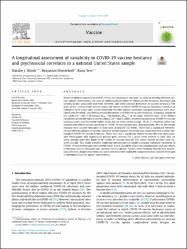Please use this identifier to cite or link to this item:
https://hdl.handle.net/20.500.11779/1982Full metadata record
| DC Field | Value | Language |
|---|---|---|
| dc.contributor.author | Shook, Natalie J. | - |
| dc.contributor.author | Oosterhoff, Benjamin | - |
| dc.contributor.author | Sevi, Barış | - |
| dc.date.accessioned | 2023-10-18T12:06:13Z | - |
| dc.date.available | 2023-10-18T12:06:13Z | - |
| dc.date.issued | 2023 | - |
| dc.identifier.citation | Shook, N. J., Oosterhoff, B., & Sevi, B. (2023). A longitudinal assessment of variability in COVID-19 vaccine hesitancy and psychosocial correlates in a national United States sample. Vaccine, 41(7), 1390-1397. | en_US |
| dc.identifier.issn | 1873-2518 | - |
| dc.identifier.issn | 0264-410X | - |
| dc.identifier.uri | https://doi.org/10.1016/j.vaccine.2022.12.065 | - |
| dc.identifier.uri | https://hdl.handle.net/20.500.11779/1982 | - |
| dc.description | National Science Foundation [BCS-2027027] | en_US |
| dc.description | This work was supported by a RAPID grant from the National Science Foundation under Award ID BCS-2027027. The funding organization was not involved in designing the study, collecting and analyzing the data, or preparing the manuscript | en_US |
| dc.description.abstract | Recent evidence suggests that COVID-19 vaccine hesitancy is not static. In order to develop effective vaccine uptake interventions, we need to understand the extent to which vaccine hesitancy fluctuates and identify factors associated with both between- and within-person differences in vaccine hesitancy. The goals of the current study were to assess the extent to which COVID-19 vaccine hesitancy varied at an individual level across time and to determine whether disgust sensitivity and germ aversion were associated with between- and within-person differences in COVID-19 vaccine hesitancy. A national sample of U.S. adults (N = 1025; 516 woman; M-age = 46.34 years, SDage = 16.56, range: 18 to 85 years; 72.6 % White) completed six weekly online surveys (March 20 - May 3, 2020). Between-person mean COVID-19 vaccine hesitancy rates were relatively stable across the six-week period (range: 38-42 %). However, there was considerable within-person variability in COVID-19 vaccine hesitancy. Approximately, 40 % of the sample changed their vaccine hesitancy at least once during the six weeks. There was a significant between-person effect for disgust sensitivity, such that greater disgust sensitivity was associated with a lower likelihood of COVID-19 vaccine hesitance. There was also a significant within-person effect for germ aversion. Participants who experienced greater germ aversion for a given week relative to their own six week average were less likely to be COVID-19 vaccine hesitant that week relative to their own six-week average. This study provides important information on rapidly changing individual variability in COVID-19 vaccine hesitancy on a weekly basis, which should be taken into consideration with any efforts to decrease vaccine hesitancy and increase vaccine uptake. Further, these findings identify-two psychological factors (disgust sensitivity and germ aversion) with malleable components that could be leveraged in developing vaccine uptake interventions. | en_US |
| dc.language.iso | en | en_US |
| dc.publisher | Elsevier Sci Ltd | en_US |
| dc.rights | info:eu-repo/semantics/openAccess | en_US |
| dc.subject | Knowledge | en_US |
| dc.subject | Personality | en_US |
| dc.subject | Sars-cov-2 | en_US |
| dc.subject | Behavior | en_US |
| dc.subject | Disgust | en_US |
| dc.subject | Prolong | en_US |
| dc.subject | Covid-19 | en_US |
| dc.subject | Vaccine hesitancy | en_US |
| dc.subject | Disease | en_US |
| dc.subject | Individual-differences | en_US |
| dc.subject | Longitudinal design | en_US |
| dc.subject | Vulnerability | en_US |
| dc.subject | Disgust sensitivity | en_US |
| dc.subject | Domains | en_US |
| dc.subject | Germ aversion | en_US |
| dc.subject | War | en_US |
| dc.title | A Longitudinal Assessment of Variability in Covid-19 Vaccine Hesitancy and Psychosocial Correlates in a National United States Sample | en_US |
| dc.type | Article | en_US |
| dc.identifier.doi | 10.1016/j.vaccine.2022.12.065 | - |
| dc.identifier.pmid | 36669969 | en_US |
| dc.identifier.scopus | 2-s2.0-85147859270 | en_US |
| dc.description.PublishedMonth | Ocak | en_US |
| dc.description.woscitationindex | Science Citation Index Expanded | - |
| dc.identifier.wosquality | Q2 | - |
| dc.description.WoSDocumentType | article | - |
| dc.description.WoSInternationalCollaboration | Uluslararası işbirliği ile yapılan - EVET | en_US |
| dc.description.WoSPublishedMonth | Şubat | en_US |
| dc.description.WoSIndexDate | 2023 | en_US |
| dc.description.WoSYOKperiod | YÖK - 2022-23 | en_US |
| dc.identifier.scopusquality | Q2 | - |
| dc.relation.publicationcategory | Makale - Uluslararası Hakemli Dergi - Kurum Öğretim Elemanı | en_US |
| dc.identifier.endpage | 1397 | en_US |
| dc.identifier.startpage | 1390 | en_US |
| dc.identifier.issue | 12 | en_US |
| dc.identifier.volume | 41 | en_US |
| dc.department | İİSBF, Psikoloji Bölümü | en_US |
| dc.relation.journal | Vaccine | en_US |
| dc.identifier.wos | WOS:000946719000001 | en_US |
| dc.institutionauthor | Sevi, Barış | - |
| item.grantfulltext | open | - |
| item.fulltext | With Fulltext | - |
| item.languageiso639-1 | en | - |
| item.openairetype | Article | - |
| item.openairecristype | http://purl.org/coar/resource_type/c_18cf | - |
| item.cerifentitytype | Publications | - |
| crisitem.author.dept | 04.02. Department of Psychology | - |
| Appears in Collections: | Psikoloji Bölümü Koleksiyonu PubMed İndeksli Yayınlar Koleksiyonu / PubMed Indexed Publications Collection Scopus İndeksli Yayınlar Koleksiyonu / Scopus Indexed Publications Collection WoS İndeksli Yayınlar Koleksiyonu / WoS Indexed Publications Collection | |
Files in This Item:
| File | Description | Size | Format | |
|---|---|---|---|---|
| 1-s2.0-S0264410X22016000-main.pdf | Full Text- Article | 312.43 kB | Adobe PDF |  View/Open |
CORE Recommender
SCOPUSTM
Citations
7
checked on Nov 16, 2024
WEB OF SCIENCETM
Citations
6
checked on Nov 16, 2024
Page view(s)
40
checked on Nov 18, 2024
Download(s)
16
checked on Nov 18, 2024
Google ScholarTM
Check
Altmetric
Items in GCRIS Repository are protected by copyright, with all rights reserved, unless otherwise indicated.